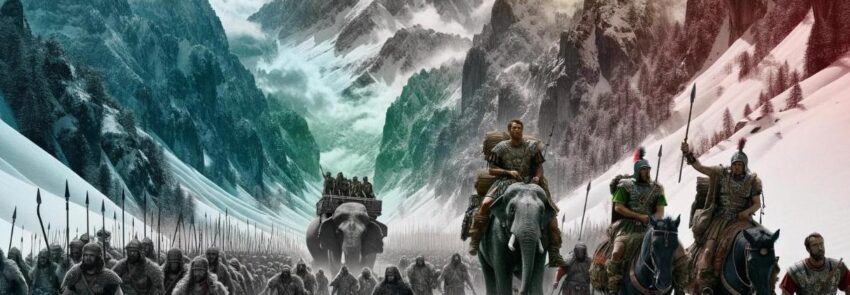Hannibal’s Rise and Strategy
Hannibal Barca, born in 247 BCE in Carthage, emerged as one of the greatest military commanders in history. His early years were shaped by the bitter memories of the First Punic War, which left Carthage humiliated and financially strained. Hannibal’s father, Hamilcar Barca, a prominent Carthaginian general, imbued him with a fierce hatred of Rome and a deep-seated desire for revenge. At the age of nine, Hannibal famously swore an oath of enmity against Rome, a vow that would define his life’s mission. Hannibal’s military career began under his father’s command in Spain, where Carthage was expanding its influence and consolidating territories. After Hamilcar’s death, his son-in-law Hasdrubal the Fair took over the command. Hannibal quickly proved himself as a competent and charismatic leader, gaining the loyalty of the troops. Upon Hasdrubal’s assassination in 221 BCE, the army elected Hannibal as commander-in-chief, a testament to his growing reputation and the respect he commanded.
Hannibal’s initial campaigns in Spain were marked by rapid and decisive actions, consolidating Carthaginian control over the region. He captured Saguntum, a Roman ally, in 219 BCE, an act that provoked Rome and marked the beginning of the Second Punic War. Hannibal’s strategy was both bold and unprecedented. Recognizing that a direct assault on Rome was impractical due to Rome’s naval superiority, Hannibal decided to bring the war to Italy itself. His plan involved an overland march from Spain, through Gaul, and over the Alps into northern Italy—a route considered impossible by many due to its length and the formidable natural barriers. In 218 BCE, with a diverse army of 50,000 infantry, 9,000 cavalry, and 37 war elephants, Hannibal set out from New Carthage (modern Cartagena). The journey through the Alps was perilous, with Hannibal’s forces facing harsh weather, treacherous terrain, and hostile tribes. The crossing, which took several weeks, resulted in significant losses; estimates suggest that he lost nearly half of his men and many of his elephants. Despite these hardships, Hannibal’s leadership and determination ensured that a substantial force reached the plains of Italy, ready to confront Rome.
Hannibal’s arrival in Italy marked the beginning of a series of engagements that would test his strategic genius and Rome’s resilience. His first major encounter with the Romans occurred at the Battle of the Ticinus River, where he successfully deployed his cavalry to secure a victory. Following this, at the Battle of the Trebia River, Hannibal’s forces once again demonstrated superior tactics, luring the Roman army into a trap and inflicting heavy casualties. These early victories bolstered Hannibal’s reputation and sowed fear within the Roman ranks. Hannibal’s next significant battle took place at Lake Trasimene in 217 BCE, where he executed one of the largest and most effective ambushes in military history. By utilizing the terrain and the element of surprise, Hannibal’s forces were able to annihilate a larger Roman force, killing thousands and capturing many others. This victory further cemented Hannibal’s status as a military mastermind and dealt a severe blow to Roman morale.
Despite these triumphs, Hannibal’s campaign faced ongoing challenges. Securing sufficient supplies and reinforcements remained a persistent issue, as Carthage was hesitant to fully commit resources to his cause. Nevertheless, Hannibal’s ability to inspire his troops and adapt to changing circumstances allowed him to maintain his campaign in Italy for several more years, setting the stage for the epic confrontations that would follow. Hannibal’s crossing of the Alps and his initial victories in Italy showcased his audacity and strategic brilliance, marking him as one of history’s most formidable military leaders.
 |
 |


